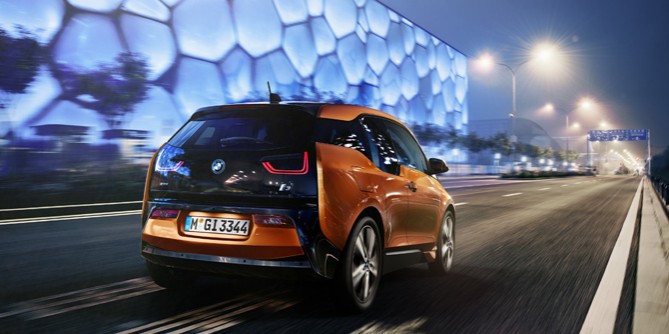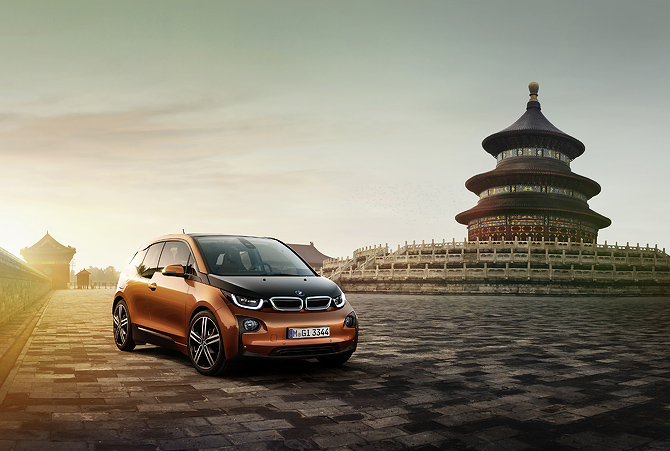
Worldwide launching of the all-new BMW i3
BMW i3
The new all-electric BMW i3 exemplifies BMW’s goal to manufacture a completely sustainable, electric auto that still remains true to the Ultimate Driving Machine tag. The BMW i3 is the very first product of the brand-new BMW i sub-brand, and is a genuinely purpose-built electric vehicle. It’s a new age for electro mobility at BMW.
The guiding principle behind the BMW i3 was that it had to be designed from the start to include an all-electric drive system. This has various advantages over converting autos that are already on sale, in which the initial combustion engine is swapped for an electric motor. The designers can create whatever operates best, in terms of construction, measurements and configuration of the electric drive system’s elements. The auto’s advancement is directed by the attributes used into the vehicle by the advancement team and not by the constraints enforced by a pre-existing auto layout. For example, the space in an existing car reserved for the fuel storage tank or exhaust system could not be used. In the BMW i3 there is no necessity for this sort of concession.

This leads to the LifeDrive architecture concept, which was purpose-built especially for the BMW i3. It is comprised of two modules; the Life Module, and the Drive Module. Consider the Life Module as the passenger cabin, or greenhouse. It is the first-ever standardized Carbon Fiber Reinforced Plastic (CFRP) guest cell in BMW’s illustrious history, and is a main factor in the vehicle’s efficiency. Carbon Fiber Reinforced Plastic is similarly as solid as steel, while being 50 % lighter, and 30 % lighter compared to light weight aluminum. The result is an electric auto that weighs in at a slim and trim 2,700 lbs (preliminary US amounts).
As a result of the lightweight, higher tensile toughness of CFRP, the guest cell has actually added protection, and the battery doesn’t have to work as hard, which permits using a smaller, lighter battery that saves much more weight, decreases charging time and increases the i3’s range on a full charge. The lightweight design of the Life Module additionally reduces the BMW i3’s center of gravity, making it a much more engaging and vibrant car to drive.
The Drive Module, which is built from 100 % light weight aluminum, consists of the 22-kWh, 450 pound. lithium-ion battery, electric drive train, MacPherson strut and 5-link rear suspension system and architectural and crash elements. The battery installed in the rear, near the drive wheels, gives outstanding efficiency characteristics while likewise providing much better traction.
Yet another benefit of the LifeDrive architecture concept is that there is no space-consuming transmission tunnel operating via the center of the automobile, like in a lot of internal combustion engine powered automobiles, as a result of the separate Drive Module. This provides the BMW i3 the interior space of the BMW 3 Series, while only having the impact of the much smaller BMW 1 Series.
Also the car’s secret is that it is sustainably manufactured. A primary example of this is a bio-polymer trick of getting castor oil from pressing castor seeds, a substance that is utilized in the i3. The owner’s manual is additionally made from renewable resources.
The inside is comprised of high quality renewable sources and recycled materials. The BMW i3 has the Next Premium interior, which blends sustainable sources with the same indoor quality as the BMW 5 Series Sedan. 25 % of the plastics in the inside and 25 % of the thermoplastic parts on the exterior are made from either recycled materials or renewable sources.
Based on studies executed as part of BMW’s Project i, involving greater than 1,000 individuals and carried out over some 12.5 million miles, it was revealed that the average everyday commute covered was around 30 miles. The BMW i3 will be able to take a trip 80 to 100 miles on a single charge. This could be boosted by up to roughly 12 % in ECO PRO mode and by the very same amount again in ECO PRO+ mode. It is able to charge in only 3 hours with the use of a 220V Level 2, 32-amp J1772 battery charger. The SAE DC Combo Fast Charging, which charges the BMW i3 up to 80 % in TWENTY minutes, and 100 % in 30 minutes, is available as an option.
In order to reduce driving range stress and anxiety, a rear-mounted 650cc, 34 hp, two-cylinder, gasoline-powered Range Extender generator is offered, which increases the vehicle’s driving range. When the battery gets to a particular state of discharge, the Range Extender begins and maintains the battery’s existing state of charge. The Range Extender never drives the auto’s tires. The Range Extender adds approximately 330 lbs. to the vehicle curb weight and has a fuel capacity of 2.4 gallons.
Starting from 1999 according to the DOE, ordinary gas costs in America have increased from about $1.136 to $3.618, or an increase of 218 %. In the very same time, the price of electricity has increased from 6.6 pennies to 9.9 pennies, a change of just 50 %, making electrical power a far more eye-catching item from a pricing point of view.
If the new all-electric BMW i3 is as good as it sounds and looks, the view to a better, brighter and more sustainable electric driving future may become a reality for many of us. Mother Nature may well be smiling somewhere on that prospect. She gets the first test drive!



